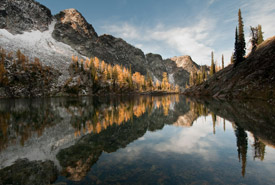Nature's way forward

Alpine Lake on Darkwoods, BC (Photo by Bruce Kirkby)
NCC’s Darkwoods property in BC provides a blueprint for how nature-based solutions can help reduce carbon emissions and mitigate the impacts of climate change
By Brian Banks, journalist and freelance writer
NCC’s Darkwoods property in BC provides a blueprint for how nature-based solutions can help reduce carbon emissions and mitigate the impacts of climate change.
If you’ve ever flown in a helicopter, you’ll know it fires up your adrenaline. But it’s something else again when that trip takes you over the top of a mountain in the middle of the Nature Conservancy of Canada’s (NCC’s) 63,000-hectare (156,000-acre) Darkwoods Conservation Area in southeastern BC, then drops you into a rare, old-growth inland temperate rainforest on an adjacent valley floor below. At that point, the adrenaline blends with feelings of reverence and inspires statements like:
“Thrilling.”
“Immeasurable value.”
“Incredibly impressed.”
Elizabeth Willmott, head of Microsoft Corp.’s carbon negative program, shared these comments during and after a site visit to Darkwoods — aloft and on foot — on a hot, blue-sky day last August. Based in neighbouring Washington state, it’s Willmott’s job to lead Microsoft’s commitment to operate carbon negative by 2030, reducing its carbon over half by 2030 and removing the rest. The purchase of carbon credits — to offset emissions that cannot currently be avoided — is part of that effort. And last year that included buying credits from the Darkwoods Forest Carbon Project, NCC’s carbon credit program.
That sale established Microsoft as one of NCC’s largest carbon credit purchasers to date. NCC organized last summer’s visit to Darkwoods to show Willmott the property’s incredible natural attributes first-hand, as well as the valuable conservation work her company’s offset purchases are helping to support. “To see the acreage protected in reality is such a huge, huge source of excitement for us,” says Willmott. It’s an excitement shared by everyone connected with Darkwoods, including Rob Wilson, NCC’s director of conservation finance. “Darkwoods is a globally significant conservation project,” says Wilson, with habitat for grizzly bears, wolverines, mountain goats, bull trout and dozens of other threatened plant and animal species, as well as connections to other protected areas.
Darkwoods’ potential for carbon credits was an important part of how NCC has been able to fund such a significant conservation project and reduce potential carbon emissions that could have resulted from intensive logging and development.
“The property would have been substantially deforested over a 15- to 20-year period had NCC not purchased it,” says Wilson. Protecting the trees at Darkwoods results in the continued storage of an estimated 19 million tonnes of carbon dioxide (CO2). Over the next century, Darkwoods will continue to sequester significant additional amounts of carbon. NCC developed the project with a team of carbon project development experts to ensure it meets the rigorous requirements of the Verified Carbon Standard (VCS), the leading international voluntary carbon market standard.
In fact, Darkwoods is VCS’s largest forest carbon project in North America. Since the program’s launch in 2011, NCC has used the funds generated through carbon credit sales to help cover the costs of managing the biodiversity of Darkwoods and other projects. “Our first mission is to conserve that land and its wildlife,” says Wilson. “And a carbon project has really supported our conservation goals.”
This is an excerpt of a story that first appeared in the spring 2020 issue of the Nature Conservancy of Canada Magazine. Donors who contribute at least $25 or more per year will receive the magazine. Click here to donate today and start receiving the magazine.



